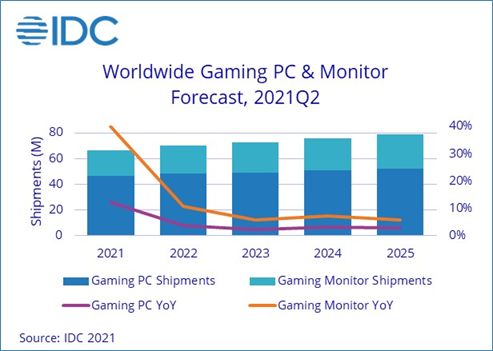Gaming PCs to Become More Expensive, Monitor Sales Will Boom: IDC
26.4 million gaming displays should ship in 2025.
While shipments of mainstream PCs are constrained by shortages of components and issues with logistics, sales of gaming monitors are growing, according to a new IDC report. The beancounters also believe the average selling prices (ASPs) of gaming PCs will increase over the next several years and that gaming PCs and display shipments will continue to grow through at least 2025.
It is noteworthy that while gaming displays are projected to become slightly cheaper in the coming years, IDC expects gaming PCs to actually increase their ASPs from $925 in 2020 to $1007 in 2025. One thing to point out here is that IDC considers any system that has more or less advanced graphics and one of the best CPUs for gaming (including those based on high-performance APUs with a decent integrated GPU, such as AMD's Ryzen 7 5700G) a gaming PC. The system does not have to be equipped with one of the best graphics cards for IDC to consider it a gaming machine. Meanwhile, because pricing for high-performance CPUs and graphics cards is sky-high because of tight supply and high MSRPs, IDC expects the average price of a gaming PC to increase in the coming years.
"Increasingly accessible price points and the ability to handle a variety of tasks outside of gaming are just some of the reasons we expect the gaming PC market to remain healthy in the coming years," said Jay Chou, research manager for IDC's Worldwide Quarterly PC Monitor Tracker. "However, even within this performance-focused segment of the market, portability is still important, and that means gaming desktops need to innovate to compete against gaming notebooks."
Last year about 14.2 million gaming displays of different kinds were shipped, IDC claims. The average selling price (ASP) of one gaming monitor was $339, well above the ASP of a regular LCD used in an office. Demand for gaming hardware in general, and gaming displays in particular, is high and is set for growth. As a result, IDC believes the total available market for gaming monitors will surge to 26.4 million units in 2025 (a compound annual growth rate of 13.2%). Meanwhile, the average price of a gaming monitor is projected to decrease to $309 in 2025.
Gaming displays aren't just an enhanced version of a mainstream monitor. Instead, they use completely different display panels with high refresh rates tailored for gamers, feature display driver ICs (DDICs) built specifically for 'fast' LCD panels, support dynamic refresh rate technologies like AMD's FreeSync or Nvidia's G-Sync, and have different menus along with various visual enhancements. To that end, shortages of 'regular' panels and DDICs don't really affect gaming panels. Meanwhile, since such high-performance components are sold at a premium, manufacturers naturally prefer to produce them instead of inexpensive parts. Likewise, display suppliers are eager to prioritize production and shipments of gaming monitors over cheap office products.
IDC's predictions about the gaming PC and display markets are similar to those of Jon Peddie Research, which predicts that the total gaming hardware market will be worth $45 billion in 2024, up from around $22 billion in 2020. Yet, IDC's predictions seem to be even bolder than JPR's. The market research firm believes that the value of the combined gaming PC and monitor markets will rise from $43 billion in 2020 to over $60 billion (a CAGR of 7.4%).
Get Tom's Hardware's best news and in-depth reviews, straight to your inbox.

Anton Shilov is a contributing writer at Tom’s Hardware. Over the past couple of decades, he has covered everything from CPUs and GPUs to supercomputers and from modern process technologies and latest fab tools to high-tech industry trends.
-
InvalidError The problem with sales of "GAMING" PC components is that components with "GAMING" branding or marketing is often the cheapest way for non-gamers to get features that cost a fortune to get on non-"GAMING" components so I suspect a lot of "GAMING" component sales are to non-gamers for non-"GAMING" uses.Reply
As for high-refresh, I wouldn't mind having 90-120Hz even as a non-gamer for smoother mouse pointer movement and reduced ghosting in videos, though I wouldn't throw out my existing monitors and TVs to get it either and I'm hoping they'll last until OLED or QD-LED become affordable. -
4freedomssake I dislike the fact that these gaming computers don't have off the shelf parts. When I went to go look for one, I had no idea who the GPU was by. Scary to me.Reply -
cryoburner ReplyIt is noteworthy that while gaming displays are projected to become slightly cheaper in the coming years, IDC expects gaming PCs to actually increase their ASPs from $925 in 2020 to $1007 in 2025.
That doesn't seem particularly noteworthy when you consider that the increase is less than the typical rate of inflation in the US. Spread out over 5 years, that only works out to around a 1.7% increase per year.
